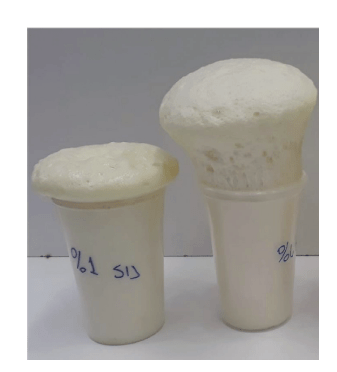Polyurethane injection material is a prepolymer material defined as a reactive tipped containing N=C=O (NCO) bonds. When these materials encounter moisture or water, they cause a chemical reaction and close their active ends. As a result of the reaction, polyurethane prepolymer material is transformed from liquid to solid form. This chemical reaction is shown in the Figure 1.

Figure 1. Reaction of Polyurethane prepolymer
Polyurethane Injection resins are materials used in negative directional water insulation applications. These resins are used in situations where a positivedirectional application is not possible or the application fails.
Injection resins can be divided into two main groups with single-component and two-component. Singlecomponent products are often used to stop water, while two-component products are systems that provide permanent sealing in the continuation of singlecomponent products.
The reaction time of polyurethane products may vary. Thus, the same product can be adjusted to different reaction start and end times according to customer request.
The type of product for optimal use should be selected based on where the application will be made. It is not correct to use the same product in every application. Different products should be preferred for applications such as tunnel, grouting, ground reinforcement& lifting, underground, etc. During the application, a product should be chosen to stop the water, and a different product should be selected to ensure permanent waterproofing. Product’s structures have different physical form as very hard, medium hard, hard, flexible and gel forms. Ideal product should be selected according to the application area.
What Should Be the Ideal Water Rate?
Special formulation design is made to keep the foam form formed by polyurethane resin in a stable skeleton as a result of its water reaction. However, there are certain conditions where this skeleton can remain stable as well as to limit everything. In case of excess of these conditions, structural condition and pore form will change.

Figure 2. Shown of ideal water rate
As seen in Figure 2, foam skeleton stability deteriorates as the number of water increases. Excess CO2, by lots of water leads to the deformation of the material and irregular pore form. Large non-homogeneous pores in the cell structure cause water leaks. This deformation and deterioration in the structure reveal the possibility of shrinkage of the material over time.
How Should the Ideal Form Structure Be?
The pore structure of flexible polyurethane foam must be small and homogeneous to provide permanent sealing of water.

Figure 3. Shown of ideal foam structure
İn Figure 3, 4% and 100% water ratios are compared to the reaction of our product. In this study, the difference is due to the amount of water. It should be noted that our product is much better than its competitors even in a 100% aqueous environment.
What Should the Ideal Swelling Rate Be?
Single-component injection materials react with water when injected into water-flowing areas or cracks. The CO2 gas, which occurs as a result of the reaction, moves the polyurethane material upwards as it moves away from the environment and ensures swelling of the polyurethane. The most important point is that the polyurethane material occurs CO2 gas as much as the amount of water it reacts with. When polyurethane reacts with excess water, it swells a lot, and when it reacts with less water, it swells slightly.
The same amount of an injection system containing resin and catalyst, when adding 1% and 4% (w/w) water by weight, the swelling rate is as in Figure 4. As a result of the reaction, more swelling is occurred in an environment with high water (4%) (ideal foam form), as more CO2
is released.

Figure 4. Shown of optimum swelling rate
How is the Application Done and What Should be Considered?
Polyurethane injection systems swell in proportion to the amount of water and isolate the water due to this swelling. As a result, it is not correct to isolate cracks filled with a product that has a very swollen and open-cell foam structure.The injection process should not be finished by stopped the water. It should be continued until the product cannot be injected from Packer systems. Polyurethane will swell a lot in its first encounter with too much water and its cellular structure will not be very impressive. Even this foam structure will be thrown out with water. This product, which comes out very swollen with water so, is not in the ideal form of the desired. This initial structural situation should not be taken into consideration. When the injection is continued, polyurethane is going to encounter less water. In this way, the inflatable rate will decrease due to water as described above, and the foam structure will become increasingly tight and will take the ideal form. In areas close to the Packers, the material will be solidified in time that will never swell.
In injection systems, the intensive supply of material to cracks provides permanent insulation. In addition, the elastomeric structure provides, there will be no leakage due to shrinkage, dissolution with water or breaking with structural movements. However, it is a fact that the injection process that is finished by stopping the water will not provide permanent sealing. Water isolation with one-component injection products should be completed with two-component injection resins that non-swelling and elastomeric. This process provides the permanent sealing of these non-foamed materials that show tolerance by stretching in static movements.
 İbrahim Kecin
İbrahim Kecin
Chemist, M.Sc.
General Manager
PURIN Polyurethane





 İbrahim Kecin
Chemist, M.Sc.
General Manager
PURIN Polyurethane
İbrahim Kecin
Chemist, M.Sc.
General Manager
PURIN Polyurethane